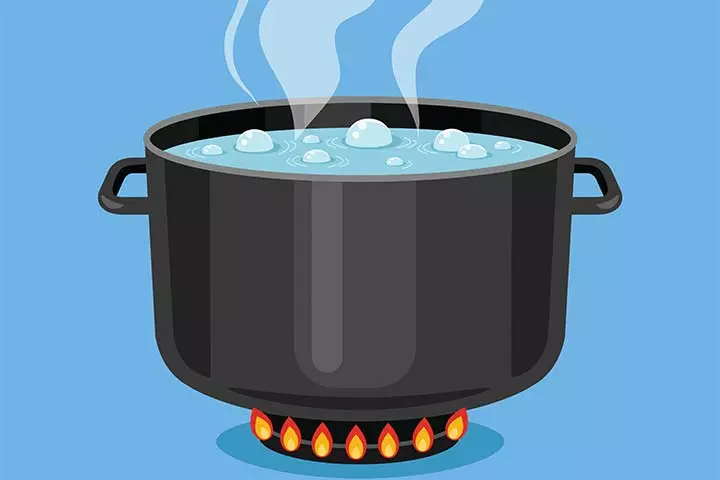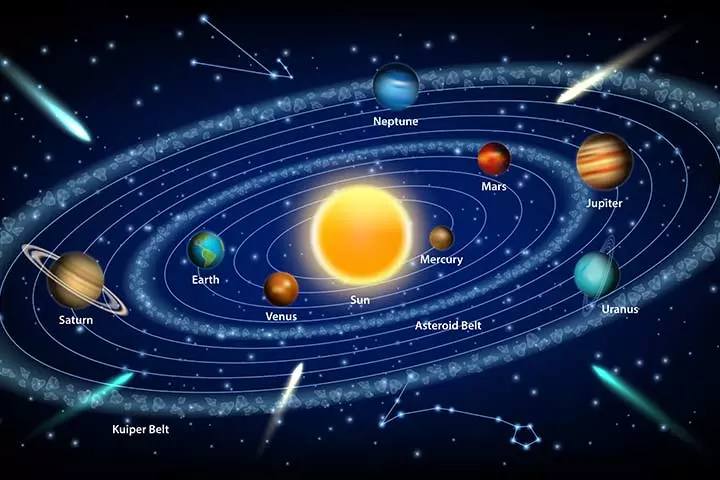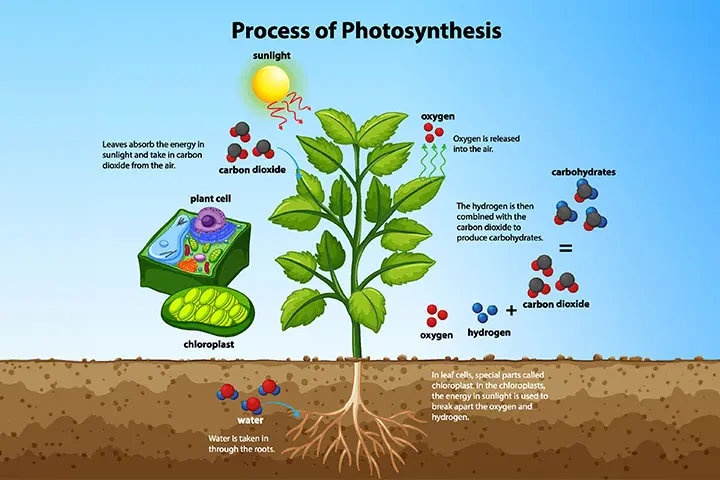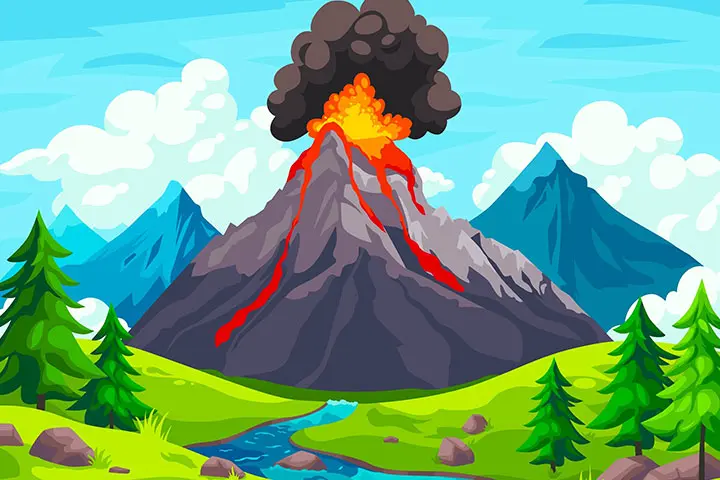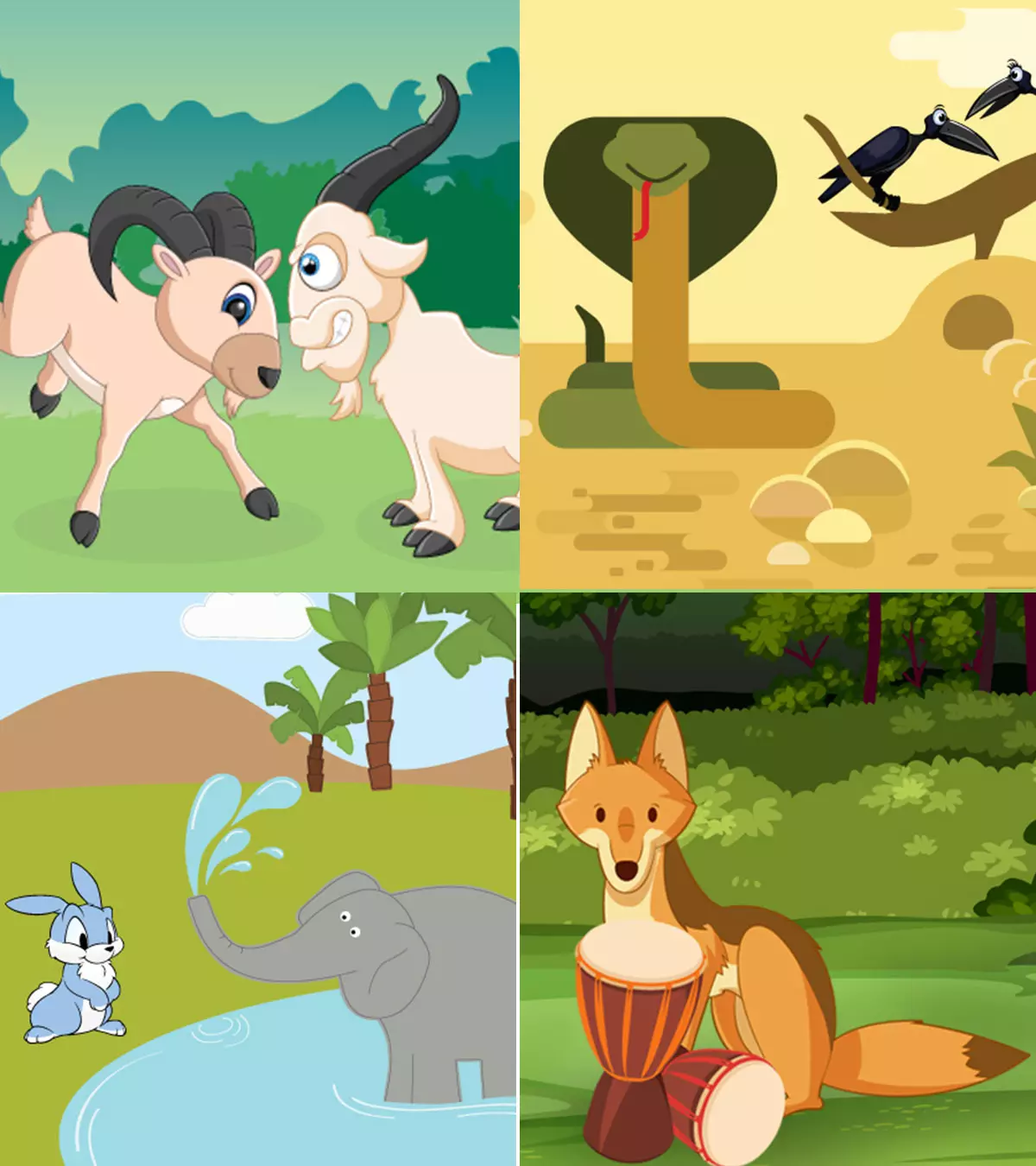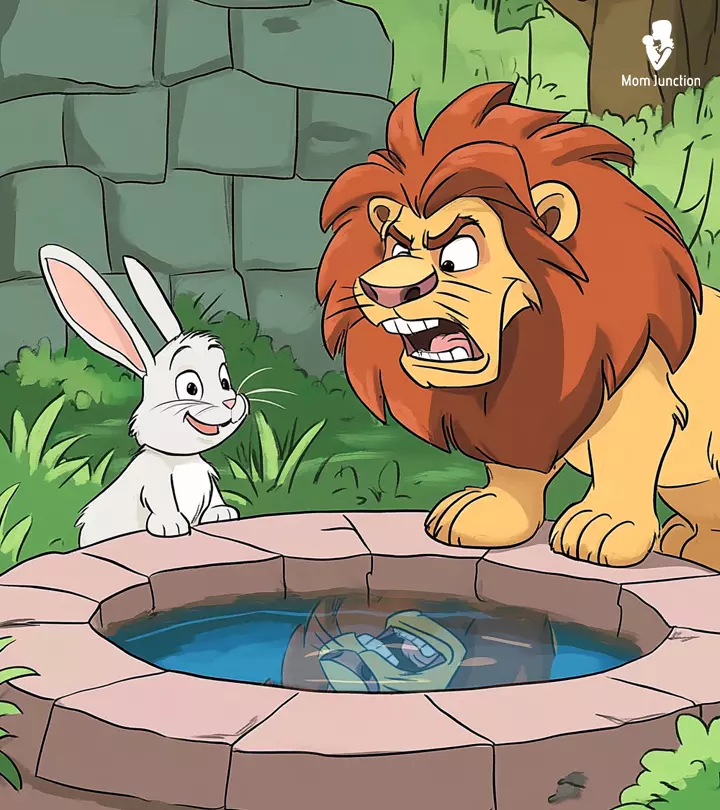

Image: Midjourney/ MomJunction Design Team
Science opens a child’s eyes to the wonders of the universe, its vibrant variety of living creatures including the plant and animal kingdom, the natural environment, and the laws that govern them all. It presents an outlet for a child’s interests, explaining how and why things happen and how the world works. We present you with some science quiz questions for kids that will pique their curiosity about the subject. A science quiz is an effective way to generate curiosity in your child and make learning a fun activity. Plunge into this post for a fascinating list of science questions with answers to make learning the subject engaging and entertaining.

Key Pointers
- Science is essential for children because it nurtures their natural curiosity about the world.
- Science quiz questions can be categorized by grade level.
- Ensuring that the content is age-appropriate and matches the child’s learning stage.
- The questions can cover many scientific topics, including biology, physics, chemistry, earth science, etc.
120 Science Quiz Questions And Answers For Kids
Science quiz questions for kids are a fun way to test their knowledge while sparking curiosity about the world around them. These interactive challenges help young learners engage with science concepts and encourage critical thinking.
Science Quiz For Grade 1
1. Which animal lays eggs?
a. Dog
b. Cat
c. Duck
d. Sheep
Answer:
Duck
2. A male cow is called?
a. Ox
b. Dog
c. Sheep
d. Monkey
Answer:
Ox
3. All animals need food, air, and ____ to survive.
a. House
b. Water
c. Chocolate
d. Fruits
Answer:
Water
4. Which one is a fur-bearing animal?
a. Hen
b. Crocodile
c. Tortoise
d. Cat
Answer:
Cat
5. What is Earth’s only natural satellite?
a. Sun
b. Mars
c. Venus
d. Moon
Answer:
Moon
6. The tree has a branch filled with green _____.
a. Hair
b. Root
c. Leaves
d. Trunk
Answer:
Leaves
7. What part of the body helps you move?
a. Eyes
b. Lungs
c. Pancreas
d. Muscles
Answer:
Muscles
8. The two holes of the nose are called?
a. Eyelids
b. Nostrils
c. Nails
d. Hair
Answer:
Nostrils
9. What star shines in the day and provides light?
a. Moon
b. Venus
c. Mars
d. Sun
Answer:
Sun
10. Legs have feet and arms have ___.
a. Ankles
b. Pelvis
c. Hands
d. Skull
Answer:
Hands
11. Which organ covers the entire body and protects it?
a. Liver
b. Heart
c. Skin
d. Brain
Answer:
Skin
12. Which shape is a round?
a. Rectangle
b. Circle
c. Square
d. Triangle
Answer:
Circle
13. Who invented the first functional telephone?
a. Albert Einstein
b. Nikola Tesla
c. Thomas Alva Edison
d. Alexander Graham Bell
Answer:
Alexander Graham Bell
 Trivia
Trivia14. What is the young one of a cow called?
a. Puppy
b. Kitten
c. Calf
d. Baby
Answer:
Calf
15. Dark rain clouds can give out lightning and ____.
a. Thunder
b. Snow
c. Sunlight
d. Wind
Answer:
Thunder
16. Your hands have four fingers and a ____.
a. Knee
b. Ankle
c. Elbow
d. Thumb
Answer:
Thumb
17. Which part of the bird lets it fly high in the sky?
a. Beak
b. Feet
c. Wings
d. Claws
Answer:
Wings
Science Quiz For Grades 2 & 3
18. Animals that suckle their young ones are called ____.
a. Reptiles
b. Birds
c. Amphibians
d. Mammals
Answer:
Mammals
19. What part of the plant conducts photosynthesis?
a. Branch
b. Leaf
c. Root
d. Trunk
Answer:
Leaf
20. What is the boiling point of water?
a. 25°C
b. 50°C
c. 75°C
d. 100°C
Answer:
100°C
21. Which is the largest land animal?
a. Lion
b. Tiger
c. Elephant
d. Rhinoceros
Answer:
Elephant
22. ____ helps pump blood through the entire body.
a. Lungs
b. Kidneys
c. Heart
d. Brain
Answer:
Heart
23. How does a dog express happiness?
a. Twitching ears
b. Moving head
c. Closing eyes
d. Wagging tail
Answer:
Wagging tail
24. What are the three states of matter?
Answer: Solid, Liquid, and Gas
25. Frog is a reptile or amphibian?
Answer: Amphibian
26. If one boils water it will convert into ____.
a. Mist
b. Steam
c. Clouds
d. Snow
Answer:
Steam
27. When you push something, you apply ____.
a. Force
b. Acceleration
c. Mass
d. Compression
Answer:
Force
28. Which group of animals have scales?
a. Mammals
b. Amphibians
c. Reptiles
Answer:
Reptiles
29. Where does our food collect after we chew and swallow it?
a. Small intestine
b. Large intestine
c. Stomach
d. Liver
Answer:
Stomach
30. Which material from the following has the highest transparency?
a. Paper
b. Wood
c. Metal
d. Glass
Answer:
Glass
31. Which animal from the below list is best adapted to the desert?
a. Tiger
b. Cheetah
c. Camel
d. Deer
Answer:
Camel
32. What part of the skeletal system protects the brain?
a. Spine
b. Thigh
c. Pelvis
d. Skull
Answer:
Skull
33. What is the name of a frog’s young one?
a. Infant
b. Puppy
c. Calf
d. Tadpole
Answer:
Tadpole
34. Which pigment gives the leaves its green color?
Answer: Chlorophyll
Science Quiz For Grades 4, 5, 6, & 7
35. What tissue connects muscles to bones?
a. Skin
b. Blood vessels
c. Fat
d. Tendon
Answer:
Tendon
36. Which nutrient plays an essential role in muscle-building?
a. Protein
b. Carbohydrate
c. Iron
d. Fat
Answer:
Protein
37. Plants need which gas to perform photosynthesis?
a. Hydrogen
b. Carbon monoxide
c. Carbon dioxide
d. Oxygen
Answer:
Carbon dioxide
38. Which scientist proposed the three laws of motion?
a. Isaac Newton
b. Thomas Alva Edison
c. Albert Einstein
d. Stephen Hawking
Answer: Isaac Newton
39. Earth is surrounded by layers of gasses collectively called the _____.
a. Hydrosphere
b. Stratosphere
c. Atmosphere
d. Ozone layer
Answer:
Atmosphere
40. Which system of the body controls the senses?
a. Circulatory system
b. Digestive system
c. Nervous system
d. Skeletal system
Answer:
Nervous system
41. Which is the largest animal on earth?
a. Shark
b. Elephant
c. Blue whale
d. Giraffe
Answer:
Blue whale
 Did you know?
Did you know?42. Similar body cells group together to form a ___.
a. Organ
b. Tissue
c. Blood vessels
d. Joints
Answer:
Tissue
43. What energy emerges from motion?
a. Potential energy
b. Electrical energy
c. Kinetic energy
d. Gravitational energy
Answer:
Kinetic energy
44. Which is the strongest sense in a dog?
a. Touch
b. Hearing
c. Smell
d. Taste
Answer:
Smell
45. The standard unit of measurement for energy is ____.
a. Newton
b. Ampere
c. Watt
d. Joule
Answer:
Joule
46. Which biologist proposed the theory of evolution through natural selection?
a. Charles Darwin
b. Stephen Hawking
c. Francesco Redi
d. Alexander Fleming
Answer:
Charles Darwin
47. What are animals, which eat both plants and animals, called?
a. Herbivores
b. Insectivores
c. Carnivores
d. Omnivores
Answer:
Omnivores
48. The outward force, away from the center, felt by an object in circular motion is ___.
a. Centripetal force
b. Circular force
c. Centrifugal forces
d. Elastic force
Answer:
Centrifugal force
49. What type of energy eventually depletes?
a. Kinetic energy
b. Non-renewable energy
c. Gravitational energy
d. Renewable energy
Answer:
Non-renewable energy
50. A single piece of coiled DNA is called ____.
a. Nucleus
b. Ribosome
c. Cytoplasm
d. Chromosome
Answer:
Chromosome
51. Yeast is a type of ____.
a. Plant
b. Animal
c. Bacterium
d. Fungus
Answer:
Fungus
52. Which is the closest planet to the sun?
a. Venus
b. Mars
c. Mercury
d. Earth
Answer:
Mercury
Science quiz for grades 8, 9, & 10
53. “For every action, there is an equal and opposite reaction.” This is Newton’s —– law of motion.
a. First Law
b. Second Law
c. Third Law
Answer:
Third Law
54.Which cell organelle is also called the powerhouse of the cell?
a. Ribosome
b. Endoplasmic reticulum
c. Cytoplasm
d. Mitochondria
Answer:
Mitochondria
55. The bending of light through a glass prism is called ____.
a. Reflection
b. Refraction
c. Diffraction
d. Absorption
Answer:
Refraction
56. A lion is most closely related to which of the following animals?
a. Dog
b. Raccoon
c. Wolf
d. Leopard
Answer:
Leopard
 Trivia
Trivia57. Newtons is the unit of force or energy?
Answer: Force
58. Diabetes happens because of problems in which organ of the body?
a. Liver
b. Heart
c. Pancreas
d. Kidneys
Answer:
Pancreas
59. Which of the following is NOT a form of carbon?
a. Diamond
b. Graphite
c. Amorphous carbon
d. Ferrite
Answer:
Ferrite
60. Sweet potato is an example of a modified _____.
a. Leaf
b. Root
c. Stem
d. Branch
Answers:
Root
61. Medicine that is given to fight bacteria but not viruses?
Answer: Antibiotic
62. Earthquakes are caused due to movements of ______.
Answer: Tectonic plates
63. An acidic liquid will have a ___ pH.
Answer: Low
64. Which is the lightest element in the periodic table?
a. Helium
b. Carbon
c. Nitrogen
d. Hydrogen
Answer:
Hydrogen
65. What elements are the most common in the human body?
a. Sulfur, sodium, magnesium
b. Phosphorus, nitrogen, calcium
c. Copper, zinc, selenium
d. Oxygen, carbon, hydrogen
Answer:
Oxygen, carbon, hydrogen
True Or False Science Questions For Kids
True or False science questions for kids are a fun and engaging way to test their knowledge while encouraging curiosity about the world. These simple questions make learning science enjoyable and help build critical thinking skills.
True Or False Questions For Grade 1
66. The sun rises in the East.
a. True
b. False
Answer:
True
67. Fish can live on land.
a. True
b. False
Answer:
False (Fish live in water)
68. An elephant is smaller than a mouse.
a. True
b. False
Answer:
False (An elephant is bigger than a mouse)
69. Water freezes at 0 degree Celsius.
a. True
b. False
Answer:
True
70. There are 7 days in a week.
a. True
b. False
Answer:
True
71. Spiders have six legs.
a. True
b. False
Answer:
False (A spider has eight legs)
72. Trees give us oxygen.
a. True
b. False
Answer:
True
73. Ice-cream is hot.
a. True
b. False
Answer:
False (Ice-cream is cold)
74. The young one of the sheep is called lamb.
a. True
b. False
Answer:
True
75. We breathe with the help of our stomachs.
a. True
b. False
Answer:
False (We breathe with the help of lungs)
True Or False Questions For Grade 2 & 3
76. There are 31 days in February in a leap year.
a. True
B. False
Answer:
False (There are 29 days in February in a leap year)
77. Dolphins are mammals.
a. True
B. False
Answer:
True
78. The tallest mountain in the world is Mount Everest.
a. True
B. False
Answer:
True
79. There are 500 bones in the human body.
a. True
B. False
Answer:
False (There are 206 bones in the human body)
80. The Pacific Ocean is the smallest ocean in the world.
a. True
B. False
Answer:
False (The Pacific Ocean is the largest ocean in the world)
81. Octopuses have three hearts.
a. True
B. False
Answer:
True
82. Venus is the closest planet to the Sun.
a. True
B. False
Answer:
False (Mercury is the closest planet to the Sun)
83. The longest river in the world is the Nile.
a. True
B. False
Answer:
True
84. Polar bears live in Antarctica.
a. True
B. False
Answer:
False (Polar bears live in the Arctic)
85. Boiling water gives out steam.
a. True
B. False
Answer:
True
True Or False Questions For Grades 4, 5, 6, & 7
86. A rainbow is more often seen in the month of monsoon.
a. True
B. False
Answer:
True
87. The change of a substance from the liquid state to the gaseous state is called Condensation.
a. True
B. False
Answer:
False (The change of a substance from the liquid state to the gaseous state is called Evaporation)
88. If pollen is passed from flower to flower, it is called Pollination.
a. True
B. False
Answer:
True
89. Acid tastes sour.
a. True
B. False
Answer:
True
90. The speed of light is faster than the speed of sound.
a. True
B. False
Answer:
True
91. The remains of once-lived living organisms are called meteorites.
a. True
b. False
Answer:
False (The remains of once-lived living organisms are called fossils)
92. Roots of a plant are responsible for absorbing water and minerals from the soil.
a. True
b. False
Answer:
True
93. Concave mirrors are used for side views in vehicles.
a. True
b. False
Answer:
False (Convex mirrors are used for side views in vehicles)
94. A merry-go-round is an example of linear motion.
a. True
b. False
Answer:
False (A merry-go-round is an example of circular motion)
95. The process by which plants use sunlight to convert carbon dioxide and water into glucose and oxygen is called photosynthesis.
a. True
b. False
Answer:
True
True Or False Questions For Grades 8, 9, & 10
96. Oxygen is the waste by-product of photosynthesis.
a. True
b. False
Answer:
True
97. Plants require nitrate ions to make chlorophyll.
a. True
b. False
Answer:
False ( Plants require nitrate ions to make proteins)
98. The acronym ISRO stands for International Space Research Organization.
a. True
b. False
Answer:
True
99. Carbohydrates are made of fatty acids.
a. True
b. False
Answer:
False (Carbohydrates are made of sugar)
100. The flow of electric current is called Electric Current.
a. True
b. False
Answer:
True
101. The SI unit of electric current is Ohm.
a. True
b. False
Answer:
False (The SI unit of electric current is Ampere)
102. The primary function of the ozone layer is to stop the UV rays from entering into the Earth’s atmosphere.
a. True
b. False
Answer:
True
103. The chemical symbol for gold is Fe.
a. True
b. False
Answer:
False (The chemical symbol for gold is Au)
Open-Ended Science Questions For Kids
Open-ended science questions for kids spark curiosity and encourage creative thinking by allowing them to explore and explain concepts. These questions help develop problem-solving skills and foster a deeper understanding of the world around them.
Open-Ended Science Questions For Grades 1 & 2
104. Why do plants need sunlight to grow?
Plants use sunlight to make food through photosynthesis.
105. What would happen if there was no rain?
Without rain, plants and animals wouldn’t have enough water, and it could lead to drought.
106. Why do animals have different kinds of teeth?
Different teeth help animals eat specific foods, like sharp teeth for meat or flat teeth for plants.
Open-Ended Science Questions For Grades 3 & 4
107. How do birds fly?
Birds fly by flapping their wings to create lift, aided by their lightweight bones and feathers.
108. What causes shadows to change size during the day?
Shadows change size as the Sun moves, making the angle of sunlight on objects vary.
109. Why is the ocean salty?
Salt comes from rocks on land that are eroded by the water and carried to the ocean.
Open-Ended Science Questions For Grades 5 & 6
110. How do magnets attract certain materials?
Magnets attract materials like iron by aligning their atoms in the same direction.
111. Why do we see different phases of the Moon?
We see phases because the Moon orbits Earth, and sunlight reflects off its surface differently.
112. What happens when ice melts?
Ice absorbs heat and changes from a solid to a liquid, which is water.
113. Why do volcanoes erupt?
Volcanoes erupt when magma, gas, and pressure build-up under the Earth’s surface and escape through openings.
Open-Ended Science Questions For Grades 7 & 8
114. Why do we hear thunder after we see lightning?
Light travels faster than sound, so we see lightning before hearing thunder.
115. What makes a rainbow appear?
Rainbow forms when sunlight passes through raindrops, causing the light to bend and split into different colors.
116. Why do some objects sink while others float?
Objects sink or float depending on whether their density is greater or lesser than water’s.
117. How does the heart circulate blood throughout the body?
The heart pumps blood by contracting its chambers, pushing oxygen-rich blood to the body and oxygen-poor blood to the lungs.
Open-Ended Science Questions For Grades 9 & 10
118. How do vaccines protect from diseases?
Vaccines train the immune system to recognize and fight harmful viruses or bacteria.
119. Why does metal feel colder than wood, even at the same temperature?
Metal conducts heat away from your hand faster than wood, making it feel colder.
120. How does global warming affect weather patterns?
Global warming causes extreme weather events by disrupting normal temperature and precipitation patterns.
What Are The Benefits Of Doing Quizzes With Kids?
Quizzes are interactive platforms that offer students opportunities to enhance their knowledge and prepare for future success beyond academics. Here are some benefits of quizzing with kids (1) (2):
- Promotes critical thinking: Indulging in quizzes encourages children to analyze, evaluate, and apply knowledge in different contexts. They challenge children to consider multiple perspectives and reason through complex problems.
- Identifies knowledge gaps: Quizzes test a child’s understanding of key concepts. It highlights the areas where further study is needed to strengthen one’s skills.
- Fosters friendly competition: Participating in quizzes introduces children to healthy competition. It helps them to perform better while fostering teamwork in group settings.
- Teaches time management: Many quizzes are time-bound, helping kids practice working efficiently under time constraints.
- Builds interaction: They provide an interactive way for children to engage with their study material, motivating them to develop a love for science and learning.
Tips For Parents To Quiz Their Kids
Children are not usually fond of quizzes as they associate them with exams and testing anxiety. To effectively ask science quiz questions and facilitate fun learning for your kids, here are some suggestions to follow:
- Quiz your child in a fun, relaxed setting, such as a family trivia night, to make the most of these quiz questions.
- While asking your kids these questions, encourage them to discuss the answers and explore the related topics together.
- To reinforce learning, encourage your kids to ask questions of their own to enhance their curiosity about science.
- Do not impose penalties for incorrect answers; explain why and how they are incorrect, so your child can understand the concepts better.
- Consider picking science topics that your child already has an interest in, such as space, animals, or plants. Once their curiosity is sated, they will eventually get interested in more topics.
Frequently Asked Questions
1. What is a science quiz bee?
The International Science Bee is a science-themed academic quiz competition in America for students from Elementary School through High School.
2. How does the science bee work?
Science bee is a buzzer-based competition consisting of qualifying stages, regional finals, and divisional championships.
3. What are the benefits of quizzes?
Quizzes make students thoroughly read the study material. They can gain the right attitude for learning, feel more confident, their curiosity is satisfied in an exciting manner, and they get an opportunity to brush up their knowledge. Besides learning reinforcement, quizzes help students with memory retention and make them more curious about the world, encouraging critical thinking. They provide an interactive way for children to engage with their study material, motivating them to develop a love for science and learning.
Most children love science because it explains the interesting things happening around them. It also develops curiosity in children, helps them explore the world, and develop life skills. Introducing more science facts to kids and interesting branches of science such as astronomy, oceanography, botany, ornithology, paleontology, and herpetology, can make them passionate about science and help them dive deep into it. You can also explore science shows for kids to introduce them to diverse topics in a fun way. Organizing a science quiz is an excellent way to engage children and improve their learning while having fun. Go through the interesting science quiz questions for kids and let your child answer them as you ask questions. You can therefore enjoy a fun-filled quiz session.
Infographic: Biological Science Quiz Questions For Kids
Biology is a branch of science that teaches us about living organisms. Quizzing can be an excellent way to make biology lessons more engaging for kids. See the infographic below to find some easy-to-hard questions to ask them on a casual day and instill interest in the subject.
Some thing wrong with infographic shortcode. please verify shortcode syntax
References
- Why are quizzes beneficial for students?
https://jeckukas.org.in/Blog/blogdetail/Why-are-quizzes-beneficial-for-Students - The Power of Quizzing: Benefits Challenges and How to Implement a Plan.
https://www.osmosis.org/blog/2025/10/05/the-power-of-quizzing-benefits-challenges-and-how-to-implement-a-plan - Interesting Facts About Telephones – The Fact File.
https://thefactfile.org/telephone-facts/ - Blue Whale Facts – Whale Facts.
https://www.whalefacts.org/blue-whale-facts/ - Difference between Lion and Leopard.
http://www.differencebetween.info/difference-between-lion-and-leopard
Community Experiences
Join the conversation and become a part of our nurturing community! Share your stories, experiences, and insights to connect with fellow parents.
Read full bio of Dr. Neha Mehta
Read full bio of Harshita Makvana
Read full bio of Deepa Thomas
Read full bio of Kavita Kankani



